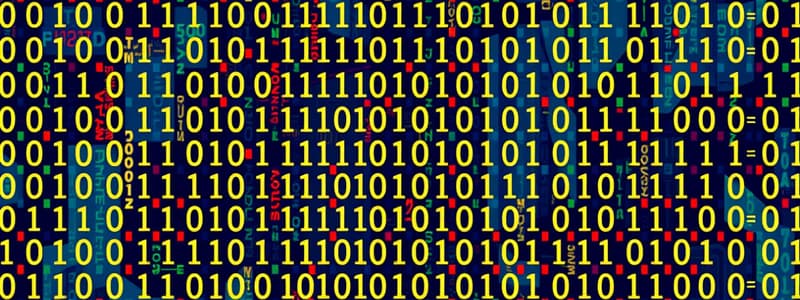Podcast
Questions and Answers
What is a bit in computing?
What is a bit in computing?
- The largest unit of data used in coding
- A single binary value of either 0 or 1 (correct)
- A sequence of instructions for a program
- A unit of data made up of four binary digits
Which error occurs when a computer calculation results in a number too small for storage?
Which error occurs when a computer calculation results in a number too small for storage?
- Roundoff Error
- Underflow Error (correct)
- Overflow Error
- Logic Error
What is the purpose of debugging in computing?
What is the purpose of debugging in computing?
- To enhance the complexity of algorithms
- To identify and fix errors in software or hardware (correct)
- To simulate a program's execution
- To convert data from binary to decimal
In programming, what does a 'sprite' refer to?
In programming, what does a 'sprite' refer to?
What is ASCII primarily used for?
What is ASCII primarily used for?
What does the RGB color model utilize to create colors?
What does the RGB color model utilize to create colors?
Which statement accurately describes heuristic problem solving?
Which statement accurately describes heuristic problem solving?
What is a key characteristic of lossless compression?
What is a key characteristic of lossless compression?
What is the purpose of a Creative Commons license?
What is the purpose of a Creative Commons license?
What does the term 'open source' refer to?
What does the term 'open source' refer to?
Flashcards are hidden until you start studying
Study Notes
Data Basics
- Bit: The smallest unit of data in a computer, with a binary value of either 0 or 1.
- Byte: A data unit consisting of eight bits, often representing a single character like a letter or number.
- Binary: A numbering system using only two digits, 0 and 1.
Programming Concepts
- Algorithm: A clear step-by-step process for completing a task or solving a problem.
- Program: A series of instructions, written in a computer language, for performing tasks or solving problems.
Snap! Programming Components
- Blocks: Puzzle-piece shapes used for coding in Snap!.
- Scripts: Connect various blocks to perform specific tasks.
- Sprites: Objects in Snap! that execute functions via scripts.
- Stage: The project background that responds to scripting.
Debugging and Errors
- Logic Error: A flaw in the algorithm or program leading to incorrect or unexpected behavior.
- Tracing: Manually simulating code execution to ensure program correctness.
- Debugging: The process of finding and fixing errors in software or hardware.
Data Representation and Errors
- ASCII: A standard character encoding system for electronic communication.
- Overflow Error: Occurs when data exceeds the storage capacity of its field.
- Roundoff Error: Arises from limitations in representing real numbers in computer calculations.
- Underflow Error: Happens when a mathematical operation produces a number too small for storage.
Pixel and Color Representation
- Pixel: A small illumination area on a display, crucial for image composition.
- RGB: Color model using red, green, and blue light to create various colors digitally.
Compression Techniques
- Heuristic: An approach to problem-solving that seeks satisfactory solutions in complex scenarios.
- Lossless Compression: A method that allows data to be perfectly reconstructed after compression.
- Lossy Compression: A technique that intentionally discards some data during compression to reduce size.
Licensing and Access
- Creative Commons: A public license facilitating the free distribution of copyrighted works.
- Open Source: Software that is freely available for use and modification.
- Open Access: Research outputs available online without restrictions on access or usage.
Studying That Suits You
Use AI to generate personalized quizzes and flashcards to suit your learning preferences.




